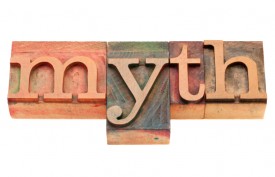
Learning disabilities can be tough to talk about and even tougher to understand. Some parents and educators prefer to call them learning differences in order to avoid negative labeling that can affect self-esteem, but the term disability is tied to special education funding by the Individuals with Disabilities Education Act (IDEA) and is a requirement for identifying and qualifying learners to receive special education services.
Regardless of what we choose to call them, learning differences or disabilities are frequently misunderstood. Pinpointing a student’s precise learning challenges can be difficult, and individual outcomes can be hard to predict. What’s more, symptoms of specific learning disabilities can be complex and confusing, and may look more like behavioral problems than learning problems to some. But some of the most common myths about learning disabilities are easy to dispel with a look at the facts.
Myth #1: Learning disabilities are intellectual disabilities.
First and perhaps most important to understand is that learning disabilities are communication differences that are completely separate from physical, developmental, and intellectual disabilities. In the same way that a hearing impaired student might need assistance in the form of a hearing aid, students with learning disabilities need assistance in the form of alternative learning methods.
When learning disabilities are identified early and dealt with effectively, students can function more or less on par with their peers in school and grow up to be self-reliant adults. Students with intellectual disabilities, on the other hand, have significantly reduced cognitive ability and usually need lifelong support from others.
Myth #2: ADHD is a learning disability.
Perhaps surprisingly, ADHD (Attention Deficit Hyperactivity Disorder) is not considered a learning disability, although it is estimated that 20-30% of people with ADHD have a learning disability as well. Learning disabilities include learning differences such as:
- Dyslexia
- Dysgraphia
- Dyspraxia
- Auditory Processing Disorder (APD)
- Language Processing Disorder
- Non-Verbal Learning Disability
- Visual Perceptual/Visual Motor Deficit
It is possible to designate ADHD as a disability under the Individuals with Disabilities Education Act (IDEA), making a student eligible to receive special education services. However, ADHD is categorized as “Other Health Impaired” and not as a “Specific Learning Disability.”
Myth #3: Dyslexia is a visual problem.
Dyslexia is one of the more commonly misunderstood learning disabilities. Many people think of it as a vision-related disorder, but it is actually rooted in differences in how the brain hears and processes spoken language. The ability to read is dependent upon the reader making accurate letter-sound correspondences, so when the brain processes spoken language atypically, it can be hard for readers to make sense of the connections between printed words and the sounds they make. The good news is that some studies have shown dyslexia to be effectively remediated by training the brain to process language more effectively.
Myth #4: The incidence of students with learning disabilities in US schools is on the rise.
The incidence of students with learning disabilities has actually declined over the past 20 years. However, other learning differences that may qualify a student for special education - such as autism and ADHD - have risen during the same time period, for reasons that are not well understood.
Food for Thought
Students with learning disabilities make up a large portion of students receiving special education services in schools - education outcomes and employment prospects for many of these students are disappointing, to say the least. Twice as many students with learning disabilities drop out as compared with their peers, and only half as many go to college. They are also twice as likely to be unemployed as adults.
With statistics like these, it’s clear that more needs to be done. Students with learning challenges need to be identified early, diagnosed accurately, provided appropriate assistive technologies, and given the right targeted interventions to help them become the best learners they can be, ready to take on new challenges with the confidence that they can succeed.
References:
Williams, D., Kingston This Week, [Letter to the editor]. Retrieved from: http://www.kingstonthisweek.com/2011/01/20/differences-between-learning-and-intellectual-disabilities
Learning disabilities and ADHD. Retrieved from: http://www.girlshealth.gov/disability/types/learning.html
ADHD. Retrieved from: http://ldaamerica.org/types-of-learning-disabilities/adhd/
Dissecting Dyslexia: Linking Reading to Voice Recognition. Retrieved from: http://www.nsf.gov/news/news_summ.jsp?cntn_id=121226
Smith, H., Auditory Processing Skills & Reading Disorders in Children. Retrieved from: http://www.scilearn.com/blog/auditory-processing-skills-reading-disorders-in-children.php
NCLD Editorial Team, Learning Disability Fast Facts. Retrieved from: http://www.ncld.org/types-learning-disabilities/what-is-ld/learning-disability-fast-facts
For Further Reading:
Related reading:
Separating Brain Fact from Brain Fiction: Debunking a Few Neuroscience Myths
Remediation vs. Accommodation: Helping Students with Learning Disabilities Succeed

